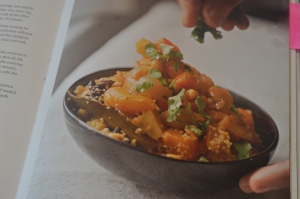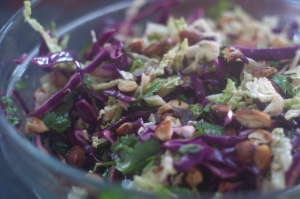I found the recipe for SpiceBoxTravels‘ Smokin’ Hot Vegan Vaquero Chili soon after the food-blogger posted it on Food52, and I couldn’t stop thinking about it. In part, I was fascinated by the beans themselves: no boring brown, the Vaquero is dappled in black and white, patterned like an Appaloosa horse.
But the recipe also got me thinking: Given The Professor’s focus on taste, interestingness, and satisfaction, a good chili would be an easy A+, right? Mouth-tingling flavor? Check. Belly-filling beans? Check. And this recipe, with its surprise ingredient, seemed to check the interesting column too.
I had to try it ASAP. So I Googled myself to heirloom bean-grower Rancho Gordo‘s website to order some Vaquero beans, waited a week for UPS to deliver the beauties, and started them soaking.
Then I diced and sauteed and boiled. And boiled some more. And a few minutes more. Finally the beans were done and I stirred in the surprise ingredient: dark chocolate.
Food52’s tester had noted that “Adding the melting chocolate at the end more than compensated for the depth meat would have added, and rounded things out for a great balance of flavors.” The tester also mentioned that she had adjusted the spice, adding just one of the chipotles in adobo sauce that the recipe called for and only a pinch of cayenne.
So with the kids in mind, I added just one chipotle and nixed the cayenne altogether. I also cut down on the chocolate — a little. And there my problems began. For the recipe to work, the sweetness needed to balance the smokin’ heat. Yet I hadn’t added much of the spice. So the result was too sweet for The Professor and me, and yet still too spicy for the kids.
The Cook will try SpiceBoxTravels‘ Smokin’ Hot Vegan Vaquero Chili again in a few years, when her eaters are ready for more spice. In the meantime, any curious cooks out there should try this recipe. As The Professor said, “The chocolate makes the recipe very rich.” And when a meat-lover calls a vegan dish “rich,” that’s saying something.
You can find the recipe here. Note: I had to cook the beans much longer than the recipe indicates.




















